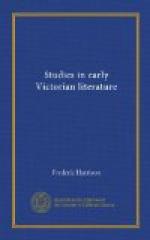But we are not willing to let the defects of Carlyle’s philosophy drive out of mind the permanent and beautiful things in his literary work. Past and Present (1843) is certainly a success—a happy and true thought, full of originality, worked out with art and power. The idea of embedding a living and pathetic picture of monastic life in the twelfth century, and a minute study of the labours of enlightened churchmen in the early struggles of civilisation—the idea of embedding this tale, as if it were the remains of some disinterred saint, in the midst of a series of essays on the vices and weaknesses of modern society—was a highly original and instructive device, only to be worked to success by a master. And the master brought it to a delightful success. In all his writings of thirty volumes there are few pages more attractive than the story of Jocelin of Brakelond, Abbot Hugo, Abbot Samson, and the festival of St. Edmund, which all pass away as in a vision leaving “a mutilated black ruin amidst green expanses”—as we so often see in our England to-day after the trampling of seven centuries over the graves of the early monks.
And then, when the preacher passes suddenly from the twelfth century to the nineteenth, from toiling and ascetic monks to cotton spinners and platform orators—the effect is electric—as though some old Benedictine rose from the dead and began to preach in the crowded streets of a city of factories. Have we yet, after fifty years of this time of tepid hankering after Socialism and Theophilanthropic experiments, got much farther than Thomas Carlyle in his preaching in Book IV. on “Aristocracies,” “Captains




